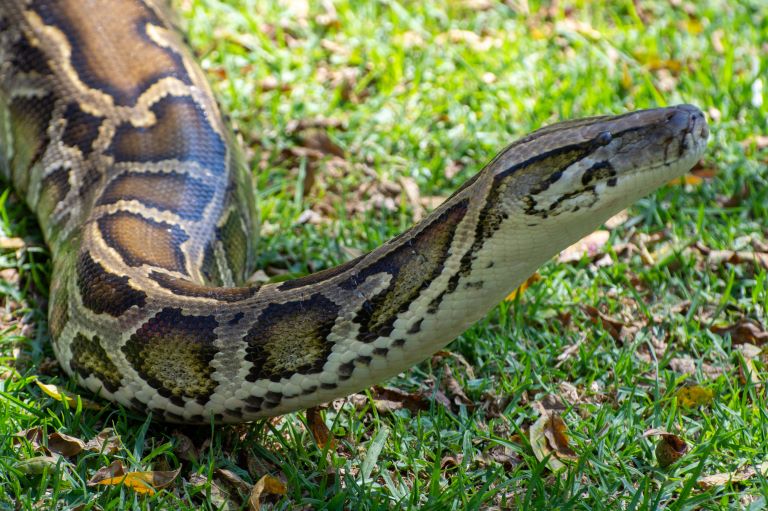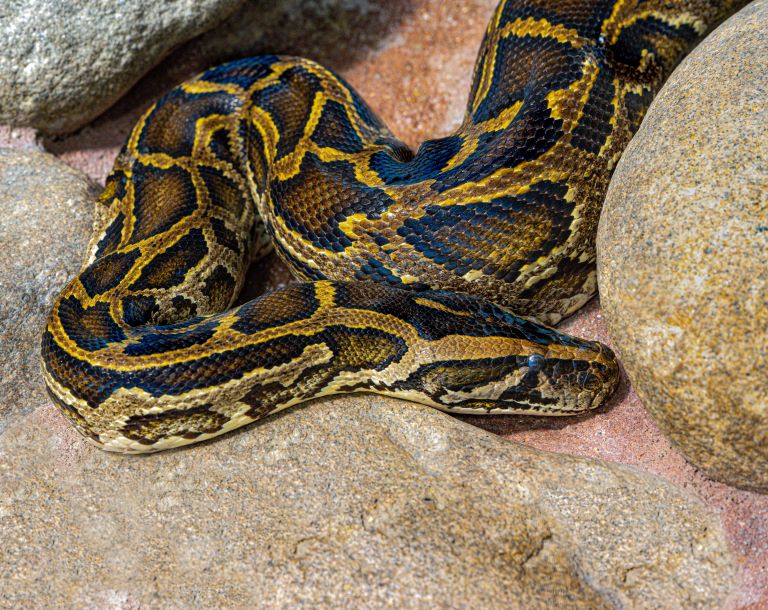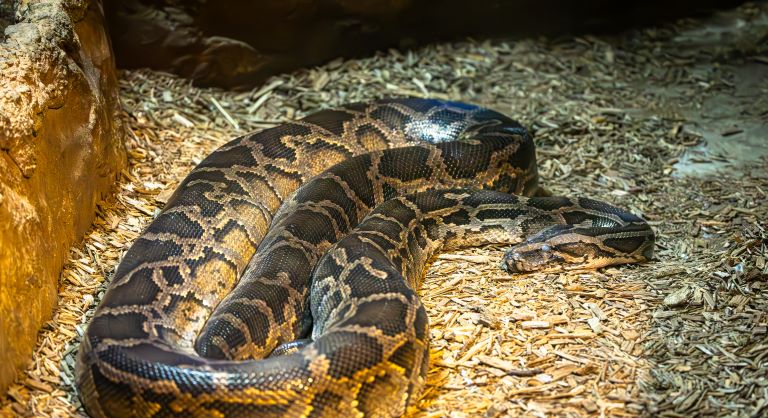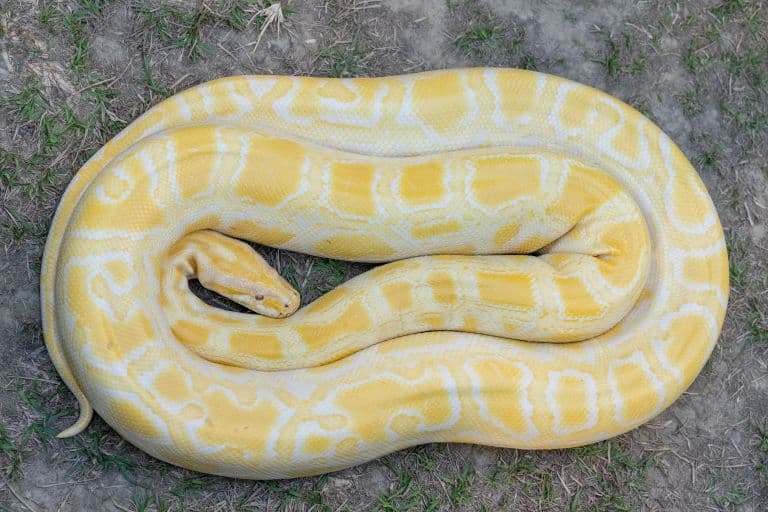Burmese Python Profile
Pythons and boas occupy very similar niches. While they evolved together, they each went their separate ways tens of millions of years ago, skulking about in rainforests in the tropics, silently crushing their prey with immense strength and a powerful squeeze.
But recently, an Asian python has made its way back to the Americas. The Burmese python is in serious contention for the title of “most dangerous non-venomous snake”, and is currently showing Florida’s alligators who’s the real prehistoric king of the swamp.

Burmese PythonFacts Overview
| Habitat: | Rainforest, grasslands, swamps, marshes and rocky foothills |
| Location: | Southern China, Burma, Indochina, Thailand and the Malay Archipelago |
| Lifespan: | 20+ years |
| Size: | Max 7.6m (25ft) |
| Weight: | Up to 90kg (200b) |
| Colour: | Tan with dark patches |
| Diet: | Birds, medium-sized mammals |
| Predators: | Only humans |
| Top Speed: | Slow |
| No. of Species: | 1 |
| Conservation Status: | Vulnerable (IUCN) |
There’s an imbalance in the protection of this species, worldwide. While they’re in serious trouble in Asia, In the US they’re being deliberately eradicated.
This is one of the largest snakes in the world, an ancient contractor, specialised in hunting mammals.
Their only predators are humans, who hunt them for their skins and meat, but this is proving to be insurmountable as the native populations begin to plummet.
Meanwhile, there is a growing population in the US that’s feeding on gators and living their best life.
Interesting Burmese Python Facts
1. They’re European
The climate in Europe 48 million years ago was much like it’s going to be in 20 years: about 10°C warmer than today, extremely wet, and with tropical storms pummelling the land.
CO2 may have reached 1000ppm, Earth had barely any ice, and sea levels were about 60cm higher than they are today.
It was around this time that pythons arrived in our fossil records, the oldest being found near an ancient lake in Germany. Interestingly, it lived alongside boas, which are now separated by continents. These two would have been direct competitors, which might explain why they decided to go their separate ways. Pythons headed Southward, migrating into Southeast Asia, and even crossing into Australia around 23 million years ago.
Pythons are now primarily in Africa and Asia, and Boas have commandeered the Americas. The python lineage has done very well for itself over this expanse of time, and the Burmese python is a great example of this success.
2. They’re adaptable
Burmese pythons occupy a range of habitats from thick jungle to open woodland, river valleys and marshes. They like to live near water, and they’re excellent swimmers.
They can eat more or less anything with a spine, and while their diet is comprised primarily of mammals, they also make the most of frogs, birds and lizards where they can be found. They’ve even been known to kill leopards.
A female snake can lay over 100 eggs and she will guard them like a basilisk until they’re hatched and off on their own way, and this means that a successful breeding season can increase population sizes significantly.
But these aren’t venomous snakes, they rely on a much older method of killing. 1

3. They’re constrictors
Constriction is a very effective way of killing an animal. Intuitively, it appears as though the snake suffocates its victim, coiling tighter on every exhalation, reducing the expansion of the lungs, and ultimately preventing new breaths from being taken.
But it appears as though this isn’t accurate. Contracting snakes kill by sheer pressure; while breathing is affected at low pressure, giants like pythons and anacondas crush their victim’s systems to the point where blood vessels close and brain damage occurs.
Working against such powerful forces, the heart becomes tired, to the point where it can’t push against the pressure, and finally stops like a stalled engine.
Fortunately, there are almost no snakes on Earth big enough to try this against a fully grown human, and unlike their spicy cousins, they have no toxins to inject you with.
But while non-venomous their teeth are still dangerous. A large Burmese python has plenty of long and painfully sharp teeth that can certainly cause deep cuts; potentially fatal if an artery is involved.
But they’re elusive and shy in the wild, and like almost all snakes, will avoid humans where possible. If cornered, they will defend themselves, but otherwise, they are not considered aggressive at all. 2
4. They’re one of the biggest snakes in the world
The sheer size of these snakes makes them formidable predators. They commonly grow to five meters long, and in exceptional cases, over seven meters.
They can weigh more than a human, too, and larger individuals are comfortable eating pigs and deer.
They don’t see well but use their incredible tongues to pick up on smells and hone in as they get nearer with thermal imaging sensors on their jaw.
One of the ways they can eat such big animals is by opening their mouths wider than most snakes. The Burmese python has a wider gape relative to its body size than most other species.
So, they’re an incredibly powerful carnivore, but in their home ranges, they’re struggling.

5. They’re being wiped out
Such a huge and good-looking snake has drawn the attention of collectors both of live and dead specimens.
Food and skins are in high demand in China and Vietnam, where there is a concoction known as “snake wine” which is essentially like sloe gin, but with a snake instead of berries.
It’s protected in China, though there’s no sign that these protections are being enforced, and habitat destruction through slash-and-burn agriculture continues to cause damage to the species all over its range.
While there are great efforts by conservationists to protect it in Asia, in the US, it’s not remotely welcome. 3
6. They’re invasive in the US
After the separation of the two competitor lineages, boas and pythons agreed never to meet again. Unfortunately, snakes aren’t known for their honour, and this deal was reneged in 1979 when a population established itself in the Florida Everglades.
Much like the residents, the wildlife in Florida has a sort of primitive, wild and dangerous air about it.
It’s a place for animals who have refused to evolve, and with the accidental reintroduction of the giant pythons, you now get to see re-enactments of epic Gondwanan battles between protosnakes and Deinosuchus that may have taken place on that same spot, 60 million years prior.
They’re a popular pet breed: almost 100,000 were imported to the US for collectors between 1996 and 2006. Some of these got too large for their owners’ liking and were released, others likely escaped. But aside from the incredible Land Before Time scenes they bring, they’re a bit of a pest in the wild.
The vast swamps of the Everglades have provided the perfect climate and habitat for this species, and for the first time in aeons, pythons and common boas – another invasive species to the region – are sharing a hunting ground again.
An immediate solution to this problem seems to be to send Burmese pythons from Florida back to Asia, perhaps on any of the countless ships of unrecyclable waste that are routinely sent from the US to Southeast Asia.
But with international relations the way they are, conservationists are looking for better solutions. 4

7. Judas Snakes
Eradication is the priority for such an invasive species, but it’s easier said than done in a vast and swampy expanse like the Everglades. Tracking snakes can sometimes bring in valuable data that can help with the program, and in some cases, leads snake killers to their targets more effectively.
As if the biblical serpent wasn’t enough of a traitor, researchers have coined another term of treachery used to describe snakes they are monitoring that, while tracked, lead the researchers to other pythons.
In 2006, one such snake led researchers to 25 invasive snakes, 19 of which were removed, and a telemetered female led them to discover a nest, proving that the species was breeding in the wild.
Burmese Python Fact-File Summary
Scientific Classification
| Kingdom: | Animalia |
| Phylum: | Chordata |
| Class: | Reptilia |
| Order: | Squamata |
| Family: | Pythonidae |
| Genus: | Python |
| Species: | Bivittatus |
Fact Sources & References
- “Python bivittatus”, USGS.
- “Burmese Python”, Florida Museum.
- “Burmese Python”, IUCN Red List.
- “Burmese Pythons in South Florida”, Florida OJ.
